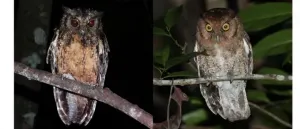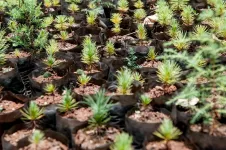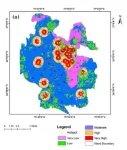A stable copper catalyst for CO2 conversion
2021-03-26
(Press-News.org) A new catalyst for the conversion of carbon dioxide (CO2) into chemicals or fuels has been developed by researchers at Ruhr-Universität Bochum and the University of Duisburg-Essen. They optimized already available copper catalysts to improve their selectivity and long-term stability. The results are described by the team led by Dr. Yanfang Song and Professor Wolfgang Schuhmann of the Bochum Center for Electrochemistry with the team led by Professor Corina Andronescu of the Duisburg-Essen Technical Chemistry III group in the journal Angewandte Chemie, published online on 9 February 2021.
Boron makes copper catalyst stable
The climate gas CO2 can be converted into larger carbon compounds that can be used as base chemicals for industry or as fuels. Researchers are pursuing the idea of converting CO2 electrochemically with the help of renewable energies. This would not only create useful products; they would also serve as storage for the renewable energies. Copper has already emerged as a promising catalyst in previous studies, but it must be in the form of a partially positively charged ion - and that is precisely the problem.
Under conventional reaction conditions, copper is rapidly converted from its positively charged form to the neutral state, which is unfavorable for the formation of products with more than two carbon atoms and thus deactivates the catalyst.
The team from Bochum and Duisburg-Essen therefore modified a copper catalyst with boron. The researchers tested different copper-boron ratios and determined the optimal composition to favor the formation of compounds with more than two carbon atoms. They also showed that the boron-copper catalyst can be operated at current densities that would be required on an industrial scale.
Zinc prevents corrosion damage
They implemented the system in the form of a gas diffusion electrode in which a solid catalyst catalyzes the electrochemical reaction between the liquid and gaseous phases. It is important that sufficient CO2 dissolves in the boundary region between the gas and liquid phases. The scientists succeeded in doing this by using a special binder.
Another challenge is to keep the system stable over a long period of time. For example, corrosion of the electrodes must be prevented. To this end, the chemists integrated a so-called sacrificial anode made of zinc into the system. Since zinc is a less noble metal than copper, this is corroded first, while the copper is spared.
"The combination of a selective and active catalyst material in a gas diffusion electrode and the addition of the stabilizing zinc is an important step towards the use of CO2 for the synthesis of base chemicals," sums up Wolfgang Schuhmann.
INFORMATION:
University Alliance Ruhr
Since 2007, the three Ruhr region universities have been engaged in close strategic cooperation under the umbrella of the University Alliance Ruhr (UA Ruhr). By pooling their strengths, the partner institutions are systematically expanding their output. There are now over 100 cooperations in the fields of research, teaching and administration, all built on the principle of being "better together". With over 120,000 students and almost 1,300 professors, the UA Ruhr is one of the largest and best-performing hubs for science and technology in Germany.
ELSE PRESS RELEASES FROM THIS DATE:
2021-03-26
Current approaches to a common and debilitating knee injury that occurs more frequently for women than men have focused for too long on biology at the expense of understanding social factors, say the authors of a new paper in the British Journal of Sports Medicine (BJSM).
Girls and women are said to be between three to six times more likely to suffer an anterior cruciate ligament (ACL) injury, where one of the key ligaments that helps to stabilise the knee joint is damaged. The devastating injury, which in extreme cases can be career ending for professional sportspeople, commonly occurs during sports that involve sudden changes in direction (e.g. basketball, football ...
2021-03-26
When the brain suffers injury or infection, glial cells surrounding the affected site act to preserve the brain's sensitive nerve cells and prevent excessive damage. A team of researchers from Charité - Universitätsmedizin Berlin have been able to demonstrate the important role played by the reorganization of the structural and membrane elements of glial cells. The researchers' findings, which have been published in Nature Communications*, shed light on a new neuroprotective mechanism which the brain could use to actively control damage following neurological injury or disease.
The nervous system lacks the ability to regenerate nerve cells and is therefore particularly vulnerable to injury. Following brain injury or infection, various cells ...
2021-03-26
An elusive whale species in the Southern Ocean could be resilient to near-future ecosystem changes, according to a new study by the universities of Exeter and Copenhagen.
Gray's beaked whales living in the deep oceans of the Southern Hemisphere are rarely seen alive and their ecology has remained a mystery to scientists until now.
The study used genome sequencing of 22 whales washed up on beaches in South Africa, Australia and New Zealand to investigate the history of the population over the past 1.1 million years.
Author of the study Dr Kirsten Thompson, of the University of Exeter, said: "The population approximately doubled about 250 thousand years ago, coinciding with a period of increased Southern Ocean productivity, sea surface temperature and a potential ...
2021-03-26
Nanowires are vital components for future nanoelectronics, sensors, and nanomedicine. To achieve the required complexity, it is necessary to control the position and growth of the metal chains on an atomic level. In the journal Angewandte Chemie, a research team has introduced a novel approach that generates precisely controlled, helical, palladium-DNA systems that mimic the organization of natural base pairs in a double-stranded DNA molecule.
A team from Europe and the USA led by Miguel A. Galindo has now developed an elegant method for producing individual, continuous chains of palladium ions. The process is based on self-organized assembly of a special palladium complex ...
2021-03-26
A new study analyzes the larval dispersal of nine fish species in the western Mediterranean and identifies three large areas in which there is barely fish exchange, so fish would remain in the same area all their life.
The study, published in the journal Progress in Oceanography, is led by experts of the Faculty of Biology of the University of Barcelona and the Biodiversity Research Institute (IRBio) of the UB, the Blanes Center for Advanced Studies (CEAB-CSIC), the Balearic Islands Coastal Observing and Forecasting System (ICTS - SOCIB), and the Mediterranean Institute for Advanced Studies (IMEDEA, CSIC-UIB).
The three identified areas are the Balearic Sea, the West Algerian Basin, and ...
2021-03-26
A new method makes it much easier to follow the progression of multiple myeloma, a form of blood cancer. With a single drop of blood, it is possible to very accurately show whether the number of cancerous cells in the bone marrow is increasing in a patient. In time, this blood test could potentially replace the current bone marrow puncture.
Researchers at Radboud university medical center, in collaboration with Erasmus MC, have taken an important step towards implementing this new diagnostic, with a study published in Clinical Chemistry. Multiple myeloma is a severe form ...
2021-03-26
Perovskites, a class of materials first reported in the early 19th century, were "re-discovered" in 2009 as a possible candidate for power generation via their use in solar cells. Since then, they have taken the photovoltaic (PV) research community by storm, reaching new record efficiencies at an unprecedented pace. This improvement has been so rapid that by 2021, barely more than a decade of research later, they are already achieving performance similar to conventional silicon devices. What makes perovskites especially promising is the manner in which they can be created. Where silicon-based devices are heavy and require high temperatures for fabrication, perovskite devices can be lightweight and formed with minimal energy investiture. It is this combination - high performance ...
2021-03-26
New study led by the University of Helsinki supports the recognition of new species of South American owls, two of them, Xingu Screech Owl and Alagoas Screech Owl, described for the first time.
In early 2021 two new species of screech owls are being described in a single publication as new to science. A multinational team involving researchers from the University of Helsinki, Brazil, and the USA published a detailed study focusing on the morphological, vocal, and genetic variation in a group of screech owls from the Amazon and Atlantic Forest regions of South America, called the Black-capped / Tawny- bellied Screech Owl complex (Megascops atricapilla - M. watsonii). The term "complex" describes ...
2021-03-26
Every year, 10 million hectares of forest are lost. Among efforts to revive degraded or deforested land is the Bonn Challenge, with a global goal to bring into restoration 350 million hectares by 2030. Yet such efforts neglect the nuanced but critical factor of bringing genetic diversity into restoration efforts for long-term success, which urgently needs to be addressed.
Integrating genetic diversity involves planting tree species with different genetic makeups and varied species adapted to local environments. If species are the same, they will not be able to reproduce or grow new seedlings. Christopher Kettle, an ecologist and geneticist at the Alliance of Bioversity International and the ...
2021-03-26
As COVID-19 vaccines slowly roll out across the world, government officials in densely populated countries must still manage vulnerable communities at highest risk of an outbreak.
In a new study published in the Journal Risk Analysis, researchers in India propose a COVID Risk Assessment and Mapping (CRAM) framework that results in a zoned map that officials can use to place more targeted restrictions on high-risk communities. Successfully used by officials in Jaipur at the peak of the pandemic last spring, their framework could help other vulnerable countries avoid a shutdown of their regional economies.
Led by Shruti Kanga, associate professor in the Centre for Climate Change and Water Research at Suresh ...
LAST 30 PRESS RELEASES:
[Press-News.org] A stable copper catalyst for CO2 conversion





